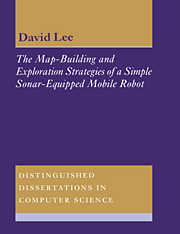 The Map-Building and Exploration Strategies of a Simple Sonar-Equipped Mobile Robot
The Map-Building and Exploration Strategies of a Simple Sonar-Equipped Mobile Robot Published online by Cambridge University Press: 05 March 2012
Chapter 12 showed the loss of map quality which arises as odometry errors accumulate and ARNE's position estimate becomes increasingly inaccurate. Chapter 9 presented a method by which ARNE can improve its position estimate by measuring the distance to known objects in its environment. The following sections describe the implementation of this localisation method and show the results of experiments to test its effectiveness.
A key component of the localisation method, the plant model, models the growth in positional uncertainty as ARNE moves. The plant model requires parameter values which are specific to the individual robot. Section 13.1 describes experiments to check that the parameters were approximately right for ARNE.
Section 13.2 then repeats the experiments from Chapter 12, but this time with the localization system in place, and compares the results. The loss of quality in the later stages of exploration is eliminated.
After the benefits of localisation have been demonstrated, Section 13.3 presents the results of wall-following with localisation in two other, more complicated, environments. The quality is shown to increase more slowly and to reach a lower maximum value in more cluttered environments. The reasons for this loss of quality are discussed.
The results of wall-following are then used to determine the best value for one of the central parameters of the map construction process, the confirmation threshold. Section 13.4 describes the experimental basis on which this choice is made.
To save this book to your Kindle, first ensure [email protected] is added to your Approved Personal Document E-mail List under your Personal Document Settings on the Manage Your Content and Devices page of your Amazon account. Then enter the ‘name’ part of your Kindle email address below. Find out more about saving to your Kindle.
Note you can select to save to either the @free.kindle.com or @kindle.com variations. ‘@free.kindle.com’ emails are free but can only be saved to your device when it is connected to wi-fi. ‘@kindle.com’ emails can be delivered even when you are not connected to wi-fi, but note that service fees apply.
Find out more about the Kindle Personal Document Service.
To save content items to your account, please confirm that you agree to abide by our usage policies. If this is the first time you use this feature, you will be asked to authorise Cambridge Core to connect with your account. Find out more about saving content to Dropbox.
To save content items to your account, please confirm that you agree to abide by our usage policies. If this is the first time you use this feature, you will be asked to authorise Cambridge Core to connect with your account. Find out more about saving content to Google Drive.